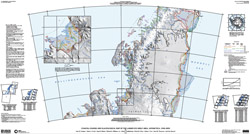Contributors: Joan Moody (DOI); Jessica K. Robertson (USGS)

- Antarctica’s glaciers are melting more rapidly than previously known because of climate change, according to a new U.S. Geological Survey report prepared in close collaboration with the British Antarctic Survey.
The USGS study documents for the first time that one ice shelf has completely disappeared and another has lost a chunk three times the size of Rhode Island. This research is part of a larger ongoing project that is for the first time studying the entire Antarctic coastline.
“This study provides the first insight into the extent of Antarctica’s coastal and glacier change,” Salazar noted. “The rapid retreat of glaciers there demonstrates once again the profound effects our planet is already experiencing—more rapidly than previously known– as a consequence of climate change. The scientific work of USGS, which is investigating the impacts of climate change around the world, including an ongoing examination of glaciers, is a critical foundation of the Administration’s commitment to combat climate change.”
The USGS study focuses on Antarctica, which is the earth’s largest reservoir of glacial ice. In a separate study published in today’s Geophysical Letters, the National Oceanic and Atmospheric Administration reports that ice is melting much more rapidly than expected in the Arctic as well, based on new computer analyses and recent ice measurements.
Using historical and recent satellite imagery, aerial photography and other data, as well as the newest mapping techniques, the USGS study released today maps recent glacier retreat along Antarctica’s Larsen and Wordie Ice Shelves. It represents is just one map of several upcoming studies of Antarctica’s glaciers. [Landsat data was heavily involved.]
Scientists previously knew that the Wordie Ice Shelf has been retreating, but this study documents for the first time that it has completely disappeared. Moreover, the northern part of the Larsen Ice Shelf no longer exists. An area more than three times the size of the State of Rhode Island (more than 8,500 km²) has broken off from the Larsen Ice Shelf since 1986.
USGS scientists report that these floating ice shelves are especially sensitive to climate change, so their rapid retreat may be a forecast for losses of the land-based ice sheet on the Antarctic continent if warming continues. This could result in sea-level rise, threatening low-lying coastal communities and islands.
“This continued and often significant glacier retreat is a wakeup call that change is happening in our Earth System and we need to be prepared,” said USGS glaciologist Jane G. Ferrigno, lead author on the study. “Antarctica is of special interest because it holds an estimated 91 percent of the Earth’s glacier volume, and change anywhere in the ice sheet poses significant hazards to society.”
The new report and map of the Larsen Ice Shelf are part of a project to research the coastal change and glaciological characteristics of the entire Antarctic margin. The research is also part of the USGS Glacier Studies Project that is monitoring and describing glacier extent and change over the whole planet using satellite imagery.
The research in Antarctica is a collaborative effort of the USGS and the British Antarctic Survey, with the assistance of the Scott Polar Research Institute and Germany’s Bundesamt für Kartographie und Geodäsie.
+ USGS Press Release
+ “Coastal-Change and Glaciological Map of the Larsen Ice Shelf Area, Antarctica: 1940-2005” report and map
+ USGS Larsen Map; full PDF version (29 Mb)






